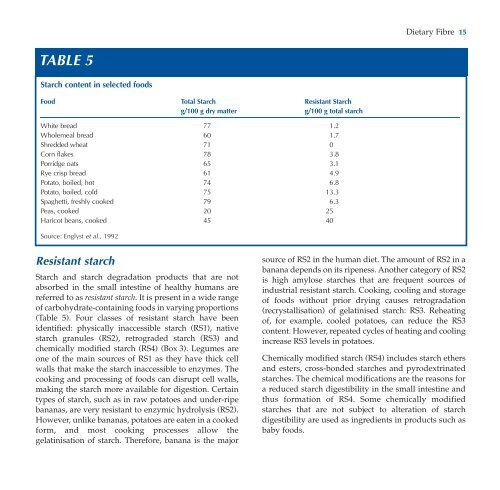Dietary Fibre - ILSI Argentina
Dietary Fibre - ILSI Argentina
Dietary Fibre - ILSI Argentina
You also want an ePaper? Increase the reach of your titles
YUMPU automatically turns print PDFs into web optimized ePapers that Google loves.
<strong>Dietary</strong> <strong>Fibre</strong> 15<br />
TABLE 5<br />
Starch content in selected foods<br />
Food Total Starch Resistant Starch<br />
g/100 g dry matter g/100 g total starch<br />
White bread 77 1.2<br />
Wholemeal bread 60 1.7<br />
Shredded wheat 71 0<br />
Corn flakes 78 3.8<br />
Porridge oats 65 3.1<br />
Rye crisp bread 61 4.9<br />
Potato, boiled, hot 74 6.8<br />
Potato, boiled, cold 75 13.3<br />
Spaghetti, freshly cooked 79 6.3<br />
Peas, cooked 20 25<br />
Haricot beans, cooked 45 40<br />
Source: Englyst et al., 1992<br />
Resistant starch<br />
Starch and starch degradation products that are not<br />
absorbed in the small intestine of healthy humans are<br />
referred to as resistant starch. It is present in a wide range<br />
of carbohydrate-containing foods in varying proportions<br />
(Table 5). Four classes of resistant starch have been<br />
identified: physically inaccessible starch (RS1), native<br />
starch granules (RS2), retrograded starch (RS3) and<br />
chemically modified starch (RS4) (Box 3). Legumes are<br />
one of the main sources of RS1 as they have thick cell<br />
walls that make the starch inaccessible to enzymes. The<br />
cooking and processing of foods can disrupt cell walls,<br />
making the starch more available for digestion. Certain<br />
types of starch, such as in raw potatoes and under-ripe<br />
bananas, are very resistant to enzymic hydrolysis (RS2).<br />
However, unlike bananas, potatoes are eaten in a cooked<br />
form, and most cooking processes allow the<br />
gelatinisation of starch. Therefore, banana is the major<br />
source of RS2 in the human diet. The amount of RS2 in a<br />
banana depends on its ripeness. Another category of RS2<br />
is high amylose starches that are frequent sources of<br />
industrial resistant starch. Cooking, cooling and storage<br />
of foods without prior drying causes retrogradation<br />
(recrystallisation) of gelatinised starch: RS3. Reheating<br />
of, for example, cooled potatoes, can reduce the RS3<br />
content. However, repeated cycles of heating and cooling<br />
increase RS3 levels in potatoes.<br />
Chemically modified starch (RS4) includes starch ethers<br />
and esters, cross-bonded starches and pyrodextrinated<br />
starches. The chemical modifications are the reasons for<br />
a reduced starch digestibility in the small intestine and<br />
thus formation of RS4. Some chemically modified<br />
starches that are not subject to alteration of starch<br />
digestibility are used as ingredients in products such as<br />
baby foods.

















